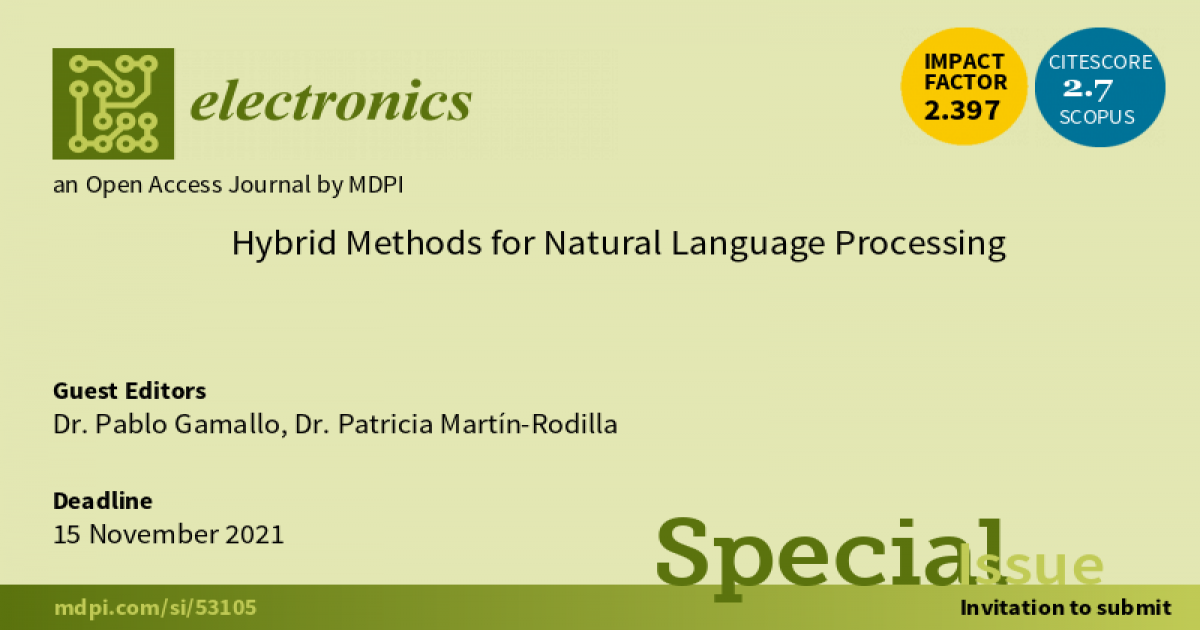Hybrid Methods for Natural Language Processing
A special issue of Electronics (ISSN 2079-9292). This special issue belongs to the section "Artificial Intelligence".
Deadline for manuscript submissions: closed (15 November 2021) | Viewed by 25272

Special Issue Editors
Interests: natural language processing; distributional semantics; information extraction; dependency parsing
Special Issues, Collections and Topics in MDPI journals
Interests: natural language processing; discourse analysis; digital humanities; knowledge representation; conceptual modelling
Special Issue Information
Dear Colleagues,
The recent improvements in machine/deep learning (M/DL) technologies do not affect all Natural Language Processing (NLP) tasks, specifically those that require deep linguistic knowledge, natural language understanding, semantic inference and reasoning. For those tasks, it is necessary to design hybrid architectures that integrate symbolic information into M/DL models so as to allow machines to learn new knowledge in a more “intelligent” way by endowing them with common sense and deep understanding. Abstract and structured knowledge from human specialists can be used not just as training data to learn uninterpretable black-box models, but also to design the models themselves by making them more transparent, easy to interpret by humans, and more efficient for specific purposes.
This Special Issue of Electronics will provide a forum for discussing exciting research on hybrid methodology for NLP tasks. It is open to any contribution that requires deep semantic analysis, such as semantic relation extraction, discourse analysis, argument mining, rumor detection, and so on. Strategies can combine statistical models with symbolic information based on propositions, regular patterns, rules, or any symbolic language aimed at representing abstract and structured commonsense knowledge.
Topics of interest of this Special Issue include, but are not limited to
Information Extraction:
- Semantic relation extraction (including Open Information Extraction);
- Discovery and identification of multi-word expressions;
- Named entity recognition and classification;
- Event detection and temporal analysis.
Language Analysis:
- Dependency parsing;
- Discourse analysis;
- Argument mining;
- Argument evaluation;
- Grammar checking.
Semantic Models:
- (Contextualized) word embeddings;
- Distributional semantics and compositionality;
- Sentence similarity and paraphrasing.
Text/Opinion Mining:
- Sentiment analysis;
- Hate speech detection;
- Rumour and fake news detection;
- Authorship attribution.
Dr. Pablo Gamallo
Dr. Patricia Martín-Rodilla
Guest Editors
Manuscript Submission Information
Manuscripts should be submitted online at www.mdpi.com by registering and logging in to this website. Once you are registered, click here to go to the submission form. Manuscripts can be submitted until the deadline. All submissions that pass pre-check are peer-reviewed. Accepted papers will be published continuously in the journal (as soon as accepted) and will be listed together on the special issue website. Research articles, review articles as well as short communications are invited. For planned papers, a title and short abstract (about 100 words) can be sent to the Editorial Office for announcement on this website.
Submitted manuscripts should not have been published previously, nor be under consideration for publication elsewhere (except conference proceedings papers). All manuscripts are thoroughly refereed through a single-blind peer-review process. A guide for authors and other relevant information for submission of manuscripts is available on the Instructions for Authors page. Electronics is an international peer-reviewed open access semimonthly journal published by MDPI.
Please visit the Instructions for Authors page before submitting a manuscript. The Article Processing Charge (APC) for publication in this open access journal is 2400 CHF (Swiss Francs). Submitted papers should be well formatted and use good English. Authors may use MDPI's English editing service prior to publication or during author revisions.
Keywords
- information extraction
- language Analysis
- semantic models
- text/opinion mining






